
An Historical Perspective on the Lab's Legacy: A Year-Long Series in The View
Part Four: Holding A Steady Course Through a Turbulent Decade
by Paul Preuss
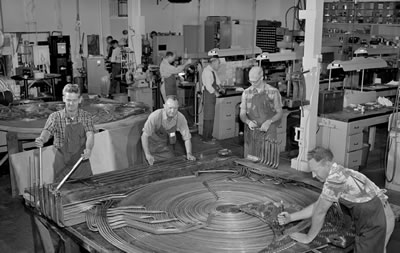
Technicians work on the magnet for the 88-inch cyclotron, 1960.
Although Ernest Lawrence lay gravely ill in the Stanford University hospital on August 8, 1958, his 57th birthday, that didn’t keep him off the phone. When Elsie McMillan, wife of Edwin McMillan and sister of Lawrence’s wife Molly, dropped by to visit, he told her he’d spoken with Clark Kerr, president of the University of California, and asked him to appoint Ed McMillan deputy director of the Radiation Laboratory.
On August 27 Lawrence died. Three weeks later McMillan became director of the university’s newly renamed Lawrence Radiation Laboratory. McMillan, 51, had won the Nobel Prize with Glenn Seaborg in 1951 for creating the first transuranium elements, and he was the independent coinventor, with Soviet physicist Vladimir Veksler, of the principal of phase stability, which enabled generations of particle accelerators to exceed the limits of the cyclotron.
As gifted and inventive a scientist as he was, McMillan’s most distinguishing characteristic as the Rad Lab’s second director was judicious calm. Given what was coming in the 1960s, nothing was more important.
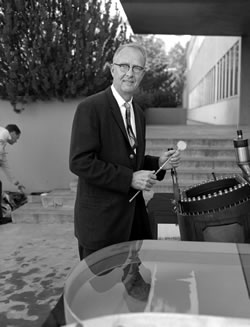
Luis Alvarez with his bubble chamber, 1968.
The decade began serenely enough. When Nikita Khrushchev replaced Stalin as head of the Soviet Union in the mid ’50s, the Cold War, which had been getting hotter, began to cool off again. By September 1959 relations had improved to the point that Khrushchev could tour the United States, an outing marred only by his disappointment at not being able to visit Disneyland.
A year later, Khrushchev was banging his shoe on a desk at the United Nations and vowing to bury us. What went wrong? For one thing, a U2 flown by CIA pilot Francis Gary Powers had been shot down over Russia. It was the start of a decade of extraordinary social and political upheaval.
The first half of the ‘60s saw the Berlin wall, the Beatles, the Stones, Dr. No, a limited test ban treaty, Marilyn Monroe’s suicide, John Kennedy’s vow to land a man on the moon “before this decade is out,” and Martin Luther King’s “I have a dream.” The second half brought flower power, psychedelics, Joplin, Hendrix, Easy Rider, 2001: A Space Odyssey, Woodstock, and Neil Armstrong’s “giant leap for mankind.”
Kennedy’s assassination cast a pall over the entire decade. Afterwards came Vietnam, riots in Watts and Detroit, the King and Robert Kennedy assassinations, and the 1968 Democratic Convention in Chicago. Berkeley, always ahead of the curve, started its Free Speech Movement in 1964; a year before Kent State, tear gas, injuries, and one fatality marked the People’s Park demonstrations of 1969.
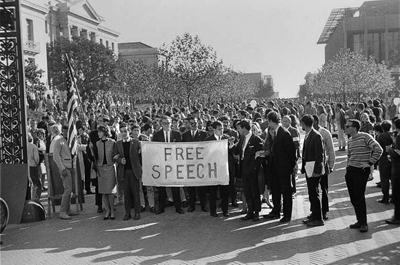
Students protest for free speech on the Berkeley campus.
Meanwhile, Edwin McMillan presided over a Laboratory that collected Nobel Prizes by the fistful, made fundamental scientific discoveries, and underwent a growth spurt. More than 40 percent of the square footage Lab employees occupy today was built during McMillan’s tenure, including Bldg. 90, Bldg. 88 and its cyclotron, the 70A and 62 laboratories, the Calvin laboratory on the UC campus, and the 50A and 50B wings of the 50 complex.
Riding the Wave
The Rad Lab’s fame was at its height and its new director played host to a stream of visiting VIPs, among them John Kennedy, Prince Philip, Princess Margaret and Lord Snowden, and numerous distinguished foreign scientists (including Vladimir Veksler). The Queen of Greece insisted that McMillan drive her around in his white and teal-blue ‘57 Thunderbird, which he regarded as “the best car ever built.”
Although McMillan struck some on the Lab staff as remote, he had a dry sense of humor. In 1959 he loaned Emilio Segrè, who’d just won the Nobel Prize with Owen Chamberlain for their discovery of the antiproton, part of the formal wear he himself had worn in Stockholm in 1951. It became a tradition for every Lab Nobel Prize winner to borrow McMillan’s white vest — the only part of his rig that fit all sizes.
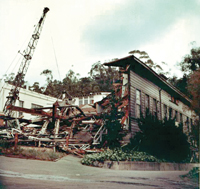
Demolition of the original Rad Lab on the campus, 1959.
Almost all the Lab’s money in these years came from the Atomic Energy Commission. Because one of President Kennedy’s first acts was to name Glenn Seaborg Chairman of the AEC, McMillan was about as well connected in Washington as a Lab director could hope to be. To avoid conflict of interest, he resigned his post on the AEC’s General Advisory Committee; still, stories made the rounds, like the one about McMillan being in conference one day near the end of the fiscal year when his phone rang, with Seaborg on the other end: “We’ve got some funds left and the year’s almost up. How fast can you propose a building?” The result, supposedly, was Bldg. 70A.
The first part of Bldg. 72 was built in 1961 to house the Inorganic Materials Research Division under Leo Brewer, for studying the effects of the nuclear reactor environment on materials; it was the forerunner of today’s Materials Sciences Division. The Lab’s 88-inch “sector-focused” cyclotron was also part of the construction boom and produced its first beam in 1962. One newspaper article described it as “a mighty midget of the modern atom-smashing arsenal.” Bernard Harvey bulldogged the project and later became the first director of the Nuclear Science Division.
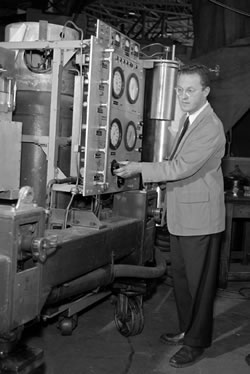
Donald Glaser with xenon bubble chamber, 1960.
In 1961 Melvin Calvin (wearing McMillan’s vest) received the Nobel Prize in chemistry for research on carbon dioxide assimilation in plants. For years he’d studied photosynthesis in the original wooden Rad Lab building, which — decrepit as it was — had the advantage of lacking internal walls. When it was torn down in 1959, Calvin saw to it that it was replaced by a cylindrical “laboratory without walls.” Opened in 1963, the Laboratory of Chemical Biodynamics became the Melvin Calvin Laboratory when he retired.
McMillan presided over the continuing march of the heavy elements, which he himself had begun by creating neptunium in 1940. Albert Ghiorso, in charge of the HILAC (Heavy Ion Linear Accelerator), was now the parade marshal. Element 102 (later nobelium), created in 1958, and element 103 (later lawrencium), created in 1961, were separated from HILAC targets by chemical means; because of their short half-lives, team member Bob Costa became known as the “fastest chemist in the West.”
In particle physics, Luis Alvarez did spectacular work with a device he’d adapted after talking to a young postdoc, Don Glaser, at an American Physical Society meeting in 1954. Taking a leaf from Lawrence’s Big Science book, Alvarez evolved, through several stages, Glaser’s notion of a “bubble chamber” a couple of inches wide until it was a gigantic steel bathtub six feet long. Even Lawrence didn’t think the monster was practical, but he arranged a whopping $2.5 million AEC grant to Alvarez. The contraption began operating at the Bevatron in March, 1959.
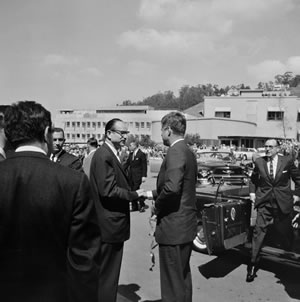
McMillan greets President John Kennedy during his visit to the Lab, 1962.
The same year saw the successful use of spark-chamber detectors by Ed Lofgren’s group. Both kinds of detectors needed advanced methods of analyzing photographs. Denis Keefe and Leroy Kerth devised the spark chamber automatic scanning system, dubbed SASS. Millions of bubble chamber photos were analyzed using early computerized machines, the first of which was called “Franckenstein” after builder James Franck.
Among the numerous discoveries were mysterious “resonances” at certain energies, fleeting events that immediately decayed into combinations of other particles. All the key resonances but one were found at the Rad Lab by 1964, after which resonance hunters needed higher energies than the Bevatron could attain. Theorist Murray Gell-Mann fit them into a scheme called the “eightfold way,” which led him to propose the existence of quarks.
Glaser (wearing McMillan’s vest) got the Nobel Prize in physics in 1960 for inventing the bubble chamber, but Alvarez had to wait until 1968 to receive his Nobel Prize (while wearing McMillan’s vest) for “decisive contributions to elementary particle physics.” Meanwhile Glaser — who had been persuaded to come to the Rad Lab in 1959 by Glenn Seaborg, then chancellor of UC Berkeley — had gotten interested in biology; by 1965 he was building computerized systems to study bacterial colonies.
Let a Thousand Flowers Bloom
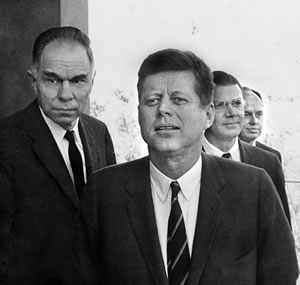
Kennedy with Seaborg (left) and McNamara (right) at the Lab.
In 1965, chemist George Pimentel (who, like Calvin, gave his name to a prominent round building on campus) sparked a hydrogen chlorine explosion with a flashlamp and converted this chemical energy directly into laser light. The world’s first chemical laser was forerunner to the most powerful continuous lasers known.
Nuclear medicine continued to thrive under John Lawrence’s directorship of the Donner Laboratory, with imaging its fastest growing field. Hal Anger had invented the gamma ray camera in the 1950s and by 1960 was using scintillating crystals to form images with positrons as well; 1963 saw the first computed tomography scanners. Physicist and medical doctor Thomas Budinger joined the Rad Lab in 1965 and pushed the field into new terrain.
In December 1966 McMillan got his first bad news from the AEC. The site for the National Accelerator Laboratory (NAL) would be neither the Rad Lab nor Brookhaven, the “obvious” choices, but rural Illinois. Spearheaded by Robert Wilson, formerly one of Lawrence’s boys, NAL would become Fermilab.
The year 1966 saw the McMillans’ younger son spend a 12-month tour of duty in Vietnam, followed by a long, difficult recovery. At the Lab, opinions were divided over the war as strongly as in the country as a whole. Elsie McMillan recalled that her husband had to “subjugate his own political or antiwar feelings to act as an unprejudiced judge for the good of all.”
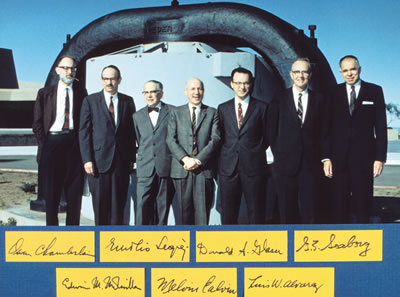
Seven Lab Nobel Laureates pose in front of Lawrence's 37-inch magnet, 1969 (from left to right) Chamberlain, McMillan, Segre, Calvin, Glaser, Alvarez, and Seaborg.
Another proposed accelerator was lost, Al Ghiorso’s Omnitron, a collider that would have accelerated nuclei from hydrogen to uranium at a wide range of energies. Ghiorso blamed the cost of the war in Vietnam. He was inspired to create the SuperHILAC, finished in 1971, and proposed sending isotopes from it to the Bevatron, a tandem arrangement that would eventually become the Bevalac.
By 1969 Ghiorso’s team had developed new techniques to create and isolate element 104 (later rutherfordium); it was a time “when the first whiffs of tear gas met you coming down the hill,” recalled team member Kari Eskola. For weeks the streets of Berkeley were occupied by the National Guard during the People’s Park confrontation. Element 105 — subject of a bitter scientific dispute and still known as hahnium to its Berkeley Lab discoverers — followed in 1970.
In 1969 controversy erupted over using Lab facilities to host political speeches; for the first time, prior approval was required to use the Bldg. 50 auditorium. McMillan was relieved when the division of the Rad Lab that was located in Livermore, CA, established by Lawrence early in the 1950s and devoted to weapons research, was split off and made a separate laboratory in 1971.
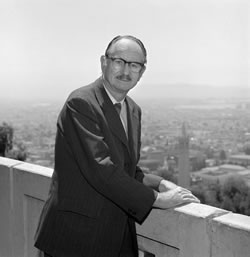
Director McMillan takes in one of the Lab's magnificent views on the Building 50 balcony.
In 1968 accelerator physicist Andrew Sessler had “called for scientists at the Rad Lab to meet and discuss what could we do about the deterioration of the environment.” Despite widespread skepticism at the Lab, Sessler and nuclear chemist Jack Hollander had McMillan’s support; when 1970 court decisions forced the AEC to take responsibility for the environmental effects of hot water discharged from nuclear power plants, funds became available for an Environmental Research Office. From this beginning the Environ-mental Energy Technologies, Earth Sciences, and Accelerator and Fusion Research Divisions later descended.
McMillan’s tenure began at the end of the 1950s, when the Lawrence Radiation Laboratory was a “paradise of physics.” By November 1972, when he announced his intention to retire, he had witnessed many exotic flowers blooming in the cyclotroneers’ Garden of Eden. They included unanticipated advances in physics and nuclear chemistry and medicine as well as in materials sciences, physical biosciences, earth sciences, and environmental studies — an increasingly diverse approach to science emblematic of a new attitude at the Lab, and its new role in society.